Registrars General
Registrars General
The post of Registrar General has changed considerably since it was first created in 1854. True to its model of economical management in Scotland, the Treasury tried to cut costs by allowing the post to be doubled with another, that of Deputy Clerk Register, and the 1854 Registration Act specifically required this. Two part-time posts would produce a comfortable salary. The Deputy Clerk Register was responsible for custody of the official records of Scotland, and his post was therefore the forerunner of the present Keeper of the Records of Scotland. The combination of posts was convenient for administration, for the records of Scotland were housed in General Register House in Edinburgh, and the new office for the Registrar General was located at first in that building, and then in New Register House next door. It required legislation, the Registrar General (Scotland) Act in 1920, to separate the two posts. Several Registrars General for Scotland had strong antiquarian interests, appropriate to their role as custodians of the Scottish national archives.
William Pitt Dundas (1801-1883)
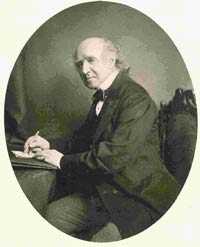 William Pitt Dundas was the first Registrar General for Scotland. His chief recommendation for this post must surely have been his name, for he belonged to one of the foremost families of Scotland. He was a double Dundas, for his father, Robert Dundas of Arniston, belonged to an ancient family of the Scottish gentry, who also occupied the highest legal positions in Scotland, and his mother, Elizabeth, was a daughter of the late Henry Dundas, first Viscount Melville. The family had extensive political connections and influence. Melville had held high office in the Tory governments of William Pitt the Younger, and had enormous power over Scottish patronage and appointments.
William Pitt Dundas was the first Registrar General for Scotland. His chief recommendation for this post must surely have been his name, for he belonged to one of the foremost families of Scotland. He was a double Dundas, for his father, Robert Dundas of Arniston, belonged to an ancient family of the Scottish gentry, who also occupied the highest legal positions in Scotland, and his mother, Elizabeth, was a daughter of the late Henry Dundas, first Viscount Melville. The family had extensive political connections and influence. Melville had held high office in the Tory governments of William Pitt the Younger, and had enormous power over Scottish patronage and appointments.
(Image: William Pitt Dundas, courtesy of Arniston House.)
The Dundas family at Arniston was large, with five children to be provided for, and Pitt Dundas was the youngest of three sons. He followed his family tradition in studying for the law, and already held the post of Deputy Clerk Register before he was appointed Registrar General. Aristocratic connections did not necessarily produce inefficient public servants. Pitt Dundas's counterpart in England, Major George Graham, had been appointed by his older brother, Sir James Graham, who was the Home Secretary. Graham was a conscientious and knowledgeable Registrar General, but research has not yet revealed that Pitt Dundas was similarly motivated towards his duties as head of the registration service. He divided his day (a fairly short morning, followed by substantial lunch and a short afternoon) between the posts of Registrar General and Deputy Clerk Register. He also spent lengthy periods in London, and was a keen traveller.
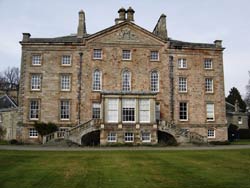 (Image: Arniston House, Pitt Dundas's family home.)
(Image: Arniston House, Pitt Dundas's family home.)
Pitt Dundas did, however, make a significant contribution to Scottish vital statistics by insisting that he should be supported in his work by a Superintendent of Statistics who was a medical man, just as Graham was supported by his Superintendent, the eminent statistician, Dr William Farr. The British Treasury in London had hoped that much of the Scottish work would be routine and economical, capable of being done by senior clerks, and that the English Registrar General would make the decisions about statistical presentation. Dundas, possibly fearing that he might have to produce his annual reports himself, successfully insisted on having his own Superintendent of Statistics, Dr James Stark. The Scottish vital statistics were therefore presented differently from those of England, and the annual reports of the Registrar General (written by Stark) have much to say about conditions in Scotland.
Pitt Dundas served as Registrar General from 12 September 1854 to 18 April 1880. He retired from office with a very comfortable pension, and Roger Montgomerie, an advocate and former MP for North Ayrshire, succeeded him. When Montgomerie died suddenly of enteric fever in October of 1880, Pitt Dundas returned to his old office until January 1881, when a new successor was appointed.
Sir Stair Agnew (1831-1916)
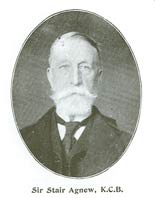 Stair Agnew, like Pitt Dundas, came from the Scottish gentry, being a younger son of Sir Andrew Agnew, 7th Baronet of Lochnaw. He took degrees at the Universities of Edinburgh and Cambridge, where he also rowed in the boat race in 1854. After a short period in the army he was called to the Scottish Bar in 1860, and was Legal Secretary to the Lord Advocate. He was appointed as Registrar General and Deputy Clerk Register in 1881. As a student, he had a distinguished career in mathematics, an appropriate background to the statistical aspects of his post. His income was enough to support a very comfortable lifestyle in Edinburgh, and in 1881, the year of his appointment, he was living in Buckingham Street with his wife and family of five children, a butler, cook, lady's maid, and three female servants. He received a knighthood in 1895, and was a fellow of the Royal Society of Edinburgh, and of the Society of Antiquaries. He retired from his post in 1909.
Stair Agnew, like Pitt Dundas, came from the Scottish gentry, being a younger son of Sir Andrew Agnew, 7th Baronet of Lochnaw. He took degrees at the Universities of Edinburgh and Cambridge, where he also rowed in the boat race in 1854. After a short period in the army he was called to the Scottish Bar in 1860, and was Legal Secretary to the Lord Advocate. He was appointed as Registrar General and Deputy Clerk Register in 1881. As a student, he had a distinguished career in mathematics, an appropriate background to the statistical aspects of his post. His income was enough to support a very comfortable lifestyle in Edinburgh, and in 1881, the year of his appointment, he was living in Buckingham Street with his wife and family of five children, a butler, cook, lady's maid, and three female servants. He received a knighthood in 1895, and was a fellow of the Royal Society of Edinburgh, and of the Society of Antiquaries. He retired from his post in 1909.
Sir James Patten MacDougall (1849-1919)
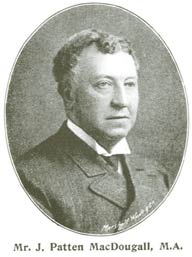 Born James Patten in 1849, he took his mother's name on inheriting her family property at Gallanach, Argyll, in 1891. His father was a lawyer, and Patten studied for the law at Oxford. Before his appointment as Registrar General in 1909 he was legal member, Vice-President and Chairman of the Local Government Board for Scotland from 1904. He also served on the famous Royal Commission on the Poor Laws and Relief of Distress, which produced a major report on poverty in Britain in 1909. During this period he continued to take a strong interest in county affairs, and was a deputy lieutenant for Argyll, and a justice of the peace. Although coming from a 'good' family was still a useful recommendation for appointment to the post of Registrar General, Patten MacDougall appears to have been a hard-working public servant with a strong interest in social issues. While his counterpart in England, Sir Bernard Mallet, was much enthused by the fashionable 'eugenic' theories of the day, and was keen to use his office as a tool for racial improvement, Patten MacDougall was more pragmatic, and disliked intrusion into personal privacy, a trait shared by his Superintendent of Statistics, James Craufurd Dunlop. Patten MacDougall was fortunate in having Dunlop in charge of statistics, and they presided over the introduction of new hollerith techniques for mechanical tabulation of the 1911 census. Patten MacDougall was knighted in 1914.
Born James Patten in 1849, he took his mother's name on inheriting her family property at Gallanach, Argyll, in 1891. His father was a lawyer, and Patten studied for the law at Oxford. Before his appointment as Registrar General in 1909 he was legal member, Vice-President and Chairman of the Local Government Board for Scotland from 1904. He also served on the famous Royal Commission on the Poor Laws and Relief of Distress, which produced a major report on poverty in Britain in 1909. During this period he continued to take a strong interest in county affairs, and was a deputy lieutenant for Argyll, and a justice of the peace. Although coming from a 'good' family was still a useful recommendation for appointment to the post of Registrar General, Patten MacDougall appears to have been a hard-working public servant with a strong interest in social issues. While his counterpart in England, Sir Bernard Mallet, was much enthused by the fashionable 'eugenic' theories of the day, and was keen to use his office as a tool for racial improvement, Patten MacDougall was more pragmatic, and disliked intrusion into personal privacy, a trait shared by his Superintendent of Statistics, James Craufurd Dunlop. Patten MacDougall was fortunate in having Dunlop in charge of statistics, and they presided over the introduction of new hollerith techniques for mechanical tabulation of the 1911 census. Patten MacDougall was knighted in 1914.
The duties of Registrar General became very heavy during the First World War, when Patten MacDougall was responsible for National Registration in Scotland, and it was necessary to confer regularly with Mallet over registration policy. Patten MacDougall continued with voluntary activities, such as the Council for the Queen Victoria Institute for Nurses, which was the main body responsible for training district nurses. But by this stage, his health was failing, and he relied increasingly on Dunlop, who succeeded him as Registrar General. He died in office in 1919. His death must have caused some difficulty, because Dunlop was particularly well qualified to replace him, but could not do so because the 1854 Registration Act stated that the post of Registrar General could be held only by a member of the Scottish Bar, i.e. a lawyer, of at least ten years standing. R.H. Gray, Secretary to Patten MacDougall, ran the office until this problem could be resolved.
Dr James Craufurd Dunlop (1865-1944)
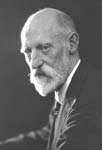
Dr James Craufurd Dunlop was appointed Registrar General for Scotland in 1921 after serving as Superintendent of Statistics at the GROS from 1904. He held the two posts concurrently until 1930, when he retired on reaching the civil service age limit.
(Image: James Craufurd Dunlop, courtesy of Lothian Health Services Archive, Edinburgh University Library.)
Born in Barrhead, Renfrewshire in 1865, Dunlop came from a well-known Glasgow merchant family, being the grandson of Henry Dunlop of Craigton. He was also the great-grandson of James Craufurd of Ardmillan, Lord Ardmillan. Dunlop's father, Colin Hinton Dunlop, died when Dunlop was still a child and he was brought up in the Edinburgh new town by his mother. Dunlop decided on a medical career, graduating from the University of Edinburgh medical school in 1887 before undertaking postgraduate studies in Strasbourg, Vienna and Paris.
On his return to Edinburgh, Dunlop gained a reputation for research that combined medical and social subjects. He worked with the distinguished physiologist, Diarmid Noel Paton, publishing several papers on human metabolism in 1896 and 1897. He also carried out an official survey of prison diets in 1899 and a survey of the diet of the labouring poor in 1901. Another of his studies looked at the reasons why petty criminals habitually re-offended. In 1891 he married Mary Duncan, daughter of an Edinburgh barrister, and they had two sons.
At the same time, Dunlop established himself as a paediatrician at the Royal Hospital for Sick Children in Edinburgh and held posts assisting the Medical Advisor to the Prison Commissioner for Scotland. He was also an Inspector under the Inebriates (Scotland) Act, under which the courts could decide to confine a persistent offender with a drink problem in a special institution. Dunlop continued to hold the last two posts after taking up the position of Superintendent of Statistics at the General Register Office for Scotland, but gave up his private medical practice.
As Superintendent of Statistics, Dunlop developed his interests in research and statistics, publishing several papers based on census and registration data. He was esteemed by the leading statisticians of the day, and, in 1925, was appointed a member of the Faculty of Actuaries, a signal honour never previously accorded to a doctor.
During the First World War, Dunlop was seconded to the War Office as Director of Statistics in the Department of Supply, dividing his time between England and Scotland. In Scotland, he oversaw the statistical side of National Registration from 1915. His appointment as Registrar General for Scotland in 1921 required an Act of Parliament to overturn the requirement in the 1854 Registration Act that the Registrar General for Scotland be a lawyer. Dunlop then held the combined posts of Registrar General and Superintendent of Statistics - the only person who has ever done so in the history of British registration.
As Registrar General, Dunlop had a special insight into issues of death registration that dominated debates on civil registration in the 1920s. Throughout his career at GROS he corresponded in detail with local Medical Officers of Health over public health issues in Scotland. He also brought Scotland into line with other developed countries by adopting the International List of the Causes of Death for death registration, though he insisted on retaining some Scottish characteristics in the medical classifications of causes of death. For example, he insisted that deaths originating in pregnancy or childbirth should be clearly attributed to those causes, and not hidden behind more specific descriptions such as 'haemorrhage'. Like William Farr and James Stark, the doctors who pioneered British vital statistics, Dunlop believed that accurate registration was a vital tool in public health, but his background in Scottish social research made him wary of some of the more extreme eugenic theories that influenced England's wartime Registrar General, Sir Bernard Mallet.
Like his contemporaries in the General Register Office for England, Dunlop was enthusiastic about new technology that promised to revolutionize the cumbersome and time-consuming task of analysing his statistical data. Before the 1911 census, he was so involved with his new hollerith machinery that he corresponded at some length with its manufacturer about how to make minor repairs himself.
During his time at GROS, Dunlop maintained an active part in Edinburgh medical life, becoming Vice President of the Royal College of Physicians of Edinburgh in 1922/3. His obituary in the College minutes in 1944 remembered:
'[His] tall active figure, taut of bearing, yet full of vitality and genial good spirits'.
All the nineteenth-century Registrars General for Scotland were lawyers, but after the law changed in 1920 to permit others to hold the office, it was held by career civil servants with administrative experience, some of whom had worked their way up in the General Register Office.
Andrew Froude (1876-1945)
Andrew Froude was the first Registrar General for Scotland who was effectively a career civil servant, without having worked in other areas. He was also the first Registrar General to show that the higher ranks of the civil service were becoming more open to men of all social classes (women usually left on marriage, and rarely reached the upper levels). Froude was the son of a blacksmith. He was born in Stonehouse in Lanarkshire in 1876, and educated at Hamilton Academy. He entered the civil service in London in 1897, and then transferred to the General Register Office in Edinburgh. In 1911 he was one of the superintendents of the census, which was a particularly elaborate exercise in that year. He was promoted in the GROS, and became Secretary (the chief administrative officer under the Registrar General) in 1925 and Registrar General in 1930. He was awarded the Imperial Service Order, and retired on account of ill health in 1937.
James Gray Kyd (1882-1968)
James Gray Kyd was born in Aberdeen. His father, Thomas, was an actuary, and a manager of the Northern Assurance Company. Kyd went to Aberdeen Grammar School, and on leaving he joined the Northern Assurance Company, and followed his father in training as an actuary via the Faculty of Actuaries. In 1912 he decided to join the civil service, possibly because the National Insurance Act of 1911 was offering new opportunities for his professional skills. He was appointed as actuary to the Irish Insurance Commission in Dublin until 1921, when he moved to a similar post in London. He was promoted, and became Secretary to the Government Actuary's Department. He was appointed Registrar General for Scotland in 1937.
Although Kyd's statistical experience was undoubtedly his major recommendation for the post, he continued the tradition of the nineteenth-century Registrars General in having a strong interest in the history and antiquities of Scotland. He was one of the founders and first chairman of the Scots Ancestry Research Society, and made a major contribution to the Third Statistical Account of Scotland, which began publication in 1951. The first and second Statistical Accounts, dating from the late eighteenth and mid-nineteenth centuries, were intended as 'Domesday books' for the Scotland of their times, and the third followed this pattern. Kyd's contribution to this publication, which used material from the historical censuses, may have been a consolation for him, since he did not have the opportunity to compile a Scottish census himself. The only census date during his term of office was 1941, when the census was suspended because of the war. The three Statistical Accounts, with their detailed local information, are invaluable sources for historians of Scotland. Kyd took the opportunity to comment on the history of Scotland's population in his book, Scottish Population Statistics, Including Webster's Analysis of Population, 1755, which was published in 1952.
Kyd maintained a close connection with the Faculty of Actuaries, serving as President from 1944 to 1946. He was also elected a Fellow of the Royal Society of Edinburgh in 1940. He retired in 1948, and continued his antiquarian interests by publishing The Drove Roads and Bridle Paths around Braemar in 1958.

